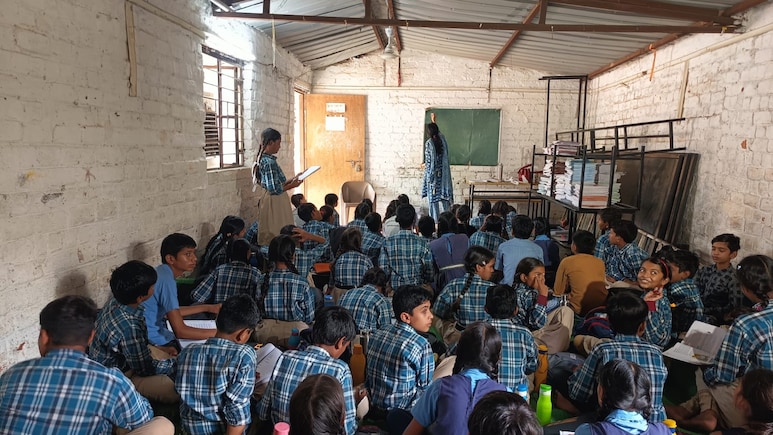
In 2021, UNESCO released a damning report: Madhya Pradesh had the highest number of single-teacher schools in India -- 21,077. Three years later, that number has dropped to 12,210, according to the Centre. But this isn't a story of progress; it's a quiet rebranding of persistent failure. In truth, across Madhya Pradesh, the public school system hasn't just deteriorated, it has collapsed.
A single-teacher school on paper might seem efficient, but in reality, it is a sentence of fatigue for both the teacher and the students. One individual, often unpaid for months, is expected to teach multiple grades, manage administrative duties, oversee mid-day meals, conduct household surveys, and maintain records - all while being the only adult in a crowded room of overburdened children. In the absence of proper staff, teachers in these schools act as peons, cleaners, cooks, and watchmen.
From the capital Bhopal to remote villages in Satna and Shivpuri, classrooms are crumbling, roofs are leaking, power is absent, and dignity has all but disappeared. Students sit in darkness, often without toilets, sometimes even without a school building.
One such story begins in Bhopal's Sandipani School in Katara Hills Barrai. Once rebranded under the ambitious Chief Minister Rise initiative, it now functions inside a rented building, under tin roofs that turn into ovens in summer and sieves during monsoon. The chaos of five classes running simultaneously in a single room has become routine.
Pranjal Srivastava, a teacher, describes the ordeal, "Classrooms are extremely small. When it rains, water seeps in. The mats children sit on are soaked and dirty. Teaching becomes a challenge. Admissions have gone up, but we don't even have enough space to seat everyone." Principal-in-Charge Disha Srivastava adds: "We've been waiting for a permanent building for three years. Every season brings new struggles - but we've tried to keep the school going. That's all we can do." Another teacher, Manoj Khare, voices a concern too many schools share: "We now have over 1,200 students, but just one bathroom. It's simply unmanageable."
Travel just a few kilometres away to Jehangiria Government School, and you'll find more despair. This is the same school that once educated former President Shankar Dayal Sharma. Today, part of its building has been sealed for safety. The ceiling leaks. Plaster falls during class. A wall ironically reads: "Smile even in sorrow." Principal Varsha Bantod pleads for intervention: "This building was donated for education. We need support to make it functional again. We're only using the safe portions for now - but for how long can we continue like this?"
And then, in Negma village of Shivpuri, the idea of a school building itself has become a memory. The structure is so decayed it's now used as a cattle shelter. Children have been shifted to a village temple, where they try to study amid religious chants and roaming livestock.
The physical decay is matched by administrative apathy. Contractors disappear. Funds remain unspent. Classrooms sanctioned years ago remain unbuilt. In some cases, buildings have been declared unsafe or simply don't exist. Basic infrastructure is missing in thousands of schools. The numbers tell their own tragic story: 9,500 schools across Madhya Pradesh still await electricity. In these buildings, students sit in dark corners, writing by the dim light from doorways. There are no fans in 45-degree summers, no bulbs in the cloudy monsoon, and no functioning digital classrooms. Of the 4,815 smart classrooms approved, only 986 are operational. It is a cruel joke to speak of "Digital India" in these rooms where even chalk and blackboard are luxuries.
For girl students, the environment is not only difficult - it is undignified. At least 1,745 government schools in the state do not have toilets for girls. This alone explains the sharp dropout rates beyond primary education. Add to this the absence of ramps in 775 schools - and it becomes clear that inclusion and accessibility are hollow words in policy papers. Meanwhile, over 3,342 classrooms remain incomplete - years after they were sanctioned and funded. The reasons are familiar: delayed payments, no contractors, political apathy, and chronic bureaucratic lethargy. In over 1,000 schools, either the building has been declared unsafe or doesn't exist at all.
Yet the state's education budget exceeds ~CHECK~6,400 crore. So, where has the money gone? School Education Minister Uday Pratap Singh defends the situation: "Under the leadership of Honorable Chief Minister Mohan Yadav, we have made preparations for the maintenance of schools and additional rooms for the construction of new schools. After getting approval from the Finance, we are going to give new rooms and we have allocated a huge amount for maintenance. There are lakhs of children and thousands of schools. I agree that there is scope for partial shortage, but still our effort is to provide the best possible resources to the children."
But children cannot sit under sincerity. They cannot shelter from rain under intentions. And they cannot learn inside slogans painted on collapsing walls. What's unfolding in Madhya Pradesh is not just a logistical failure.
Track Latest News Live on NDTV.com and get news updates from India and around the world

